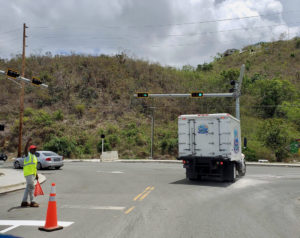
The U.S. Department of Transportation now says the Turpentine Run Project, known on St. Thomas as “the Bridge to Nowhere,” will be completed on Sept. 30, four months later than the finish projection of of May 30, offered in January.
A Department of Transportation construction status report dated June 11 said it is 89.9 percent complete.
V.I. Source has filed multiple Freedom of Information Act requests for financial statements covering “any completed road construction project on the USVI.” For Turpentine Run, the Transportation
Department’s Jan. 31 report said the project was 87 percent complete, and listed May 30 as the target for 100 percent completion.
The project has cost more than $28 million to date, if one adds up all the appropriations since 1997. But the current Transportation Department accounting puts the project’s total cost at $12.3 million and shows a beginning date of October 17, 2016. It does not include $11 million delivered to the territory for work done between 1997 and 2013 at Turpentine Run.
According to the June 11 report, with the newly adjusted completion target date, the project is ahead of schedule, with only 88.2 percent of the allotted project time used.
“The Turpentine Run Project is what is called a ‘design/build’ project that is not for public bid but a request for proposals from all contractors interested in performing the work. This type of award is based on ‘best value’ instead of ‘lowest responsible bid’,” Jose David, Department of Transportation project manager said.
“The risk in design/build contracts is passed all to the contractor. The contractor is responsible for omissions and errors in design and is expected to correct and cover the cost for those,” he said.
In other words there are no changes or contract modifications – cost overruns – adding to the cost of the construction. Estimate payments are made by percentage of construction completed.
“Contract modifications have been executed for additional time due to Hurricanes Irma and Maria and to complications of an existing Waste Management sewer line that prevents work on the project to be completed,” David said.
After 22 years of construction, the Transportation Department continues to approve funding and to modify the completion date.
In September 2016, Island Roads was awarded a contract for $9.5 million to finish the 0.34 mile project.
Dozens of requests for information to the V.I. Department of Public Works, Governor’s Office, and the V.I. Territorial Emergency Management Agency have not produced current financial reports. VITEMA has not published an annual report since 2014.
The V.I. Public Finance Authority has a report posted online showing $1.77 billion in “major federal funding awarded to the U.S. Virgin Islands to assist in its response, recovery and resiliency from Hurricanes Irma and Maria.” Last November it reported $1.49 billion, an increase of $280 million in the last seven months.
When asked about how Turpentine Run will be deemed completed, David outlined the process.
“The final inspection is done by the project manager, Federal Highway Administration, along with the owners (V.I. Department of Public Works), and the contractor (in this case Island Roads Corporation).
Usually when all items of work included in the contract are complete, the Highway Administration will call for a final walkthrough inspection, he said.
During final walkthrough inspection, the Federal Highway Administration and V.I. Public Works Department can ask for repairs or additional work within the scope of the project to be completed.
“This is what we call a final inspection ‘punch list’ and is given to the contractor for completion. When the punch list is completed the owner has the option of a second final inspection or they can provide final acceptance letter,” he said.
In the last three months, the traffic signals have been installed. Sidewalks and railing are nearing completion. The intersection appears far from the architectural rendering produced by Public Works in 2012, when they estimated it would take 18 months to finish.
One St. Thomas commuter said “I really wished they had an actual roundabout there instead of a stop light. Now that the stop lights are working there is always traffic by the race track.”


